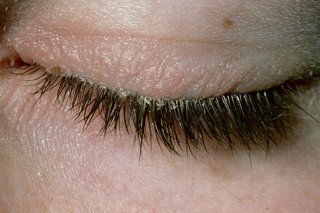Blepharitis causes red, swollen and itchy eyelids. It can normally be treated by washing your eyelids every day. The condition is not usually serious, but can lead to other problems, such as dry eyes, cysts and conjunctivitis, especially if it's not treated.
Check if you have blepharitis
Blepharitis symptoms often come and go.
Symptoms of blepharitis include:
- sore eyelids
- itchy eyes
- a gritty feeling in the eyes
- flakes or crusts around the roots of the eyelashes
- red eyes or eyelids
- eyelids sticking together in the morning when you wake up

DR P. MARAZZI/SCIENCE PHOTO LIBRARY
If you're not sure it's blepharitis
Read more about eyelid problems.
Things you can do to treat and prevent blepharitis
Do
- clean your eyelids at least once a day
- continue to clean your eyes, even if your symptoms clear up
Don't
- do not wear contact lenses while you have symptoms
- do not use eye makeup, especially eyeliner, while you have symptoms
How to clean your eyes
- Soak a clean flannel or cotton wool in warm water and place on your eye for 10 minutes.
- Gently massage your eyelids for around 30 seconds.
- Clean your eyelids using cotton wool or a cotton bud. It might help to use a small amount of baby shampoo in water.
Ask a pharmacist how to treat blepharitis
A pharmacist might suggest things to help keep your eyelids clean, including:
- eye pads and wipes
- eyedrops
Non-urgent advice: See a GP if:
- your symptoms do not improve after a few weeks of cleaning your eyelids
Treatment for blepharitis from a GP
Your GP might suggest antibiotic creams or drops. If these do not help after 6 weeks, they may recommend antibiotic tablets.
What causes blepharitis?
Blepharitis can be caused by:
- a type of bacteria that lives on the skin
- a skin condition, such as atopic dermatitis
Blepharitis cannot be spread to other people.
Page last reviewed: 28 April 2019
Next review due: 28 April 2022
